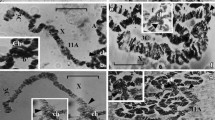Abstract
Variations in compaction of chromosomal material of the rearrangements Dp(1;f) 1337, Dp(1;f) R, Dp(1;1)pn2b, and T(1;4)w m258-21, which display an extended position effect, were characterized. Morphological changes found in these rearangements were assigned to two major types: (i) continuous compaction, in which bands and interbands located distal to the eu/heterochromatin junction fuse into one compacted block of chromatin. The extent of compaction is increased by enhancers of position effect (low temperature, removal of the Y or 2R chromosome heterochromatin). In extreme cases compaction extends over dozens of bands. (ii) Discontinuous compaction, in which at least two zones of compaction separated by morphologically normal zones can readily be identified. As a result, some regions located at a greater distance from heterochromatin may be compacted more frequently than others than map nearer to it. A few regions (1D, 2B1-12, 2D) were shown to be most frequently compacted in all rearrangements investigated. The 2B13-18, 2C1-2, 2E, and 2F regions exhibited the lowest frequencies of compaction. Compaction of the zone containing the 2B1-12 bands is always accompanied by inactivation of the ecs locus, which maps in the 2B3-5 puff. At the same time the 2C1-2 and 2E bands located nearer to the breakpoint can retain normal morphology and puffing in response to ecdysterone. The results are interpreted as morphological manifestations of the discontinuity of the spreading effect.
Similar content being viewed by others
References
Ananiev EV (1974) Investigation of DNA replication and transcription in polytene chromosomes. Ph D thesis, Institute of Atomic Energy, Moscow
Ananiev EV, Gvozdev VA (1974) Changed pattern of transcription and replication in polytene chromosomes of Drosophila melanogaster resulting from eu- and heterochromatin rearrangement. Chromosoma 45:173–191
Belyaeva ES, Aizenzon MG, Kiss I, Gorelova TD, Pak SD, Umbetova GH, Kramers PGN, Zhimulev IF (1982) Reports on new mutants. Dros Inf Serv 58:184–190
Brown Sh, Rastan S (1988) Age-related reactivation of an X-linked gene close to the inactivation center in the mouse. Genet Res 52:151–154
Clark SH, Chovnick A (1986) Studies of normal and position-effected expression of rosy region genes in Drosophila melanogaster. Genetics 114:819–840
Cowell JK, Hartmann-Goldstein IJ (1980) Modification on the DNA content in translocated regions of Drosophila polytene chromosomes. Chromosoma 81:55–64
Hartmann-Goldstein J (1967) On the relationship between heterochromatization and variegation in Drosophila, with special reference to temperature-sensitive period. Genet Res 10:143–159
Lindsley DL, Grell EN (1968) Genetic variations of Drosophila melanogaster. Carnegie Inst Wash Publ N627
Reuter G, Werner W, Hoffmann HJ (1982) Mutants affecting position-effect heterochromatization in Drosophila melanogaster. Chromosoma 85:539–551
Schultz J (1947) The nature of heterochromatin. Cold Spring Harbor Symp Quant Biol 12:179
Schultz J (1956) The relation of heterochromatic chromosome regions to the nucleic acids of the cell. Cold Spring Harbor Symp Quant Biol 21:307
Schultz J (1965) Genes, differentiation and animal development. Brookhaven Symp Biol 18:116–147
Spofford JB (1976) Position-effect variegation in Drosophila. Genetics 25:534
Tolchkov EV, Balakireva MD, Alatorcev VE (1984) Inactivation of the X chromosome region with a known fine structure as a result of the variegated position effect in Drosophila melanogaster. Genetics (USSR) 20:1846–1856
Zhimulev IF, Belyaeva ES, Fomina OV, Protopopov MO, Bolshakov VN (1986) Cytogenetical and molecular aspects of position effect variegation in Drosophila melanogaster. II. Morphology and genetic activity of the 2AB region in chromosome rearrangement T(1;2)dorvar7. Chromosoma 94:492–504
Zhimulev IF, Belyaeva FS, Bgatov AV, Baritcheva EM, Vlassova IE (1988) Cytogenetic and molecular aspects of position effect variegation in Drosophila melanogaster. II. Peculiarities of morphology and genetic activity of the 2B region in the T(1;2)dorvar7 chromosome in males. Chromosoma 96:255–261
Zhimulev IF, Belyaeva ES, Bolshakov VN, Mal'ceva NI (1989) Position-effect variegation and intercalary heterochromatin: a comparative study. Chromosoma 98:378–387
Author information
Authors and Affiliations
Additional information
by W. Beermann
Rights and permissions
About this article
Cite this article
Belyaeva, E.S., Zhimulev, I.F. Cytogenetic and molecular aspects of position effect variegation in Drosophila . Chromosoma 100, 453–466 (1991). https://doi.org/10.1007/BF00364556
Received:
Accepted:
Issue Date:
DOI: https://doi.org/10.1007/BF00364556




